Exploring Leadership: Traits, Contingency, and Followership Analysis
VerifiedAdded on 2023/06/10
|12
|2659
|276
Essay
AI Summary
This essay presents a critical analysis of leadership, focusing on three key challenges: leadership traits, contingency approaches to leadership, and followership. It discusses the Fiedler Contingency Model, highlighting its limitations and the importance of adapting leadership styles to specific situations. The essay emphasizes the significance of followership, outlining the qualities of good followers and their role in organizational success, using Sundar Pichai, the CEO of Google, as an example. Furthermore, it explores essential leadership traits, drawing from Raymond Cattell's Leadership Potential equation, and concludes that effective leaders embody honesty, emotional stability, assertiveness, and a commitment to their organization's welfare. The essay also underscores the importance of being a good follower before becoming a successful leader, exemplified by Sundar Pichai's journey to becoming the CEO of Google. The document includes a list of references.
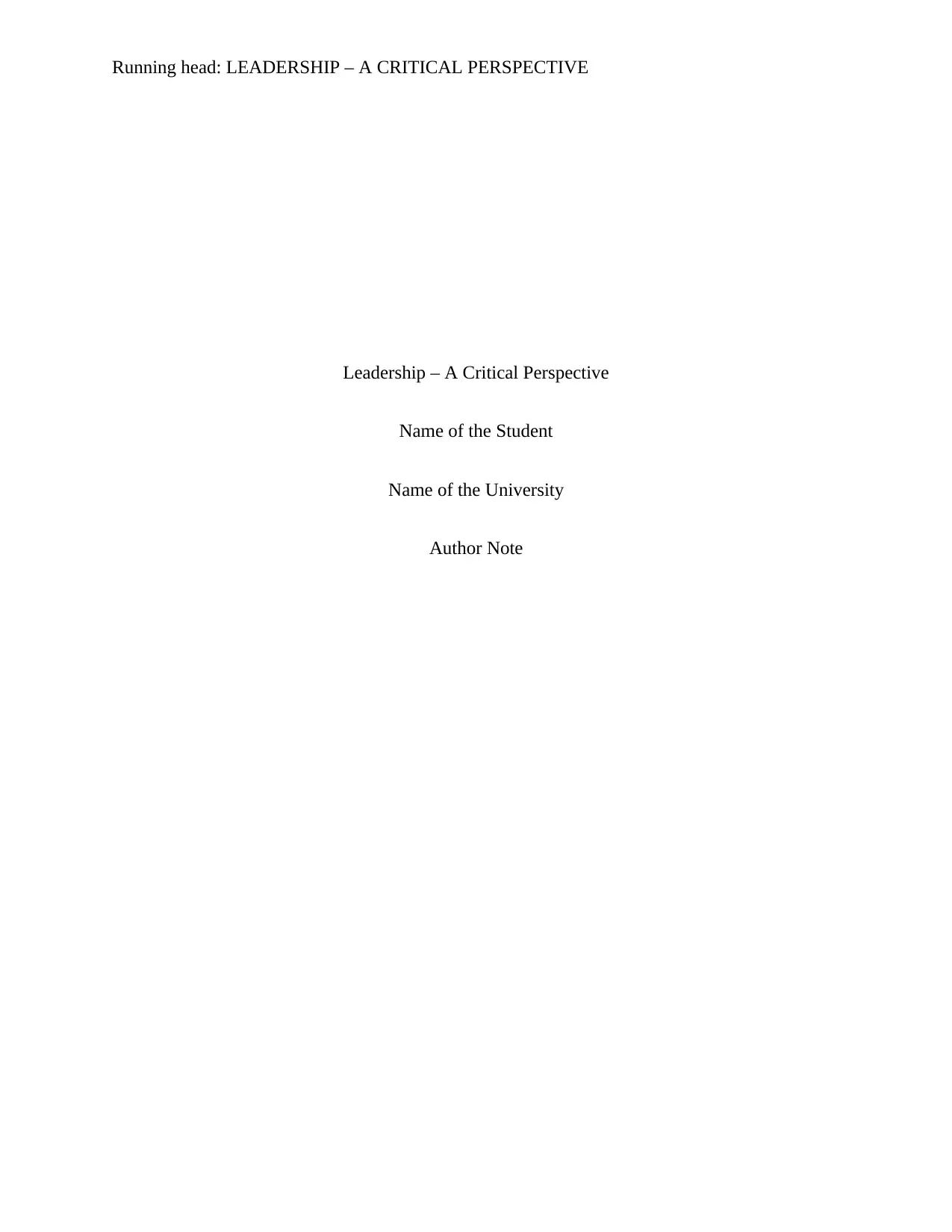
Running head: LEADERSHIP – A CRITICAL PERSPECTIVE
Leadership – A Critical Perspective
Name of the Student
Name of the University
Author Note
Leadership – A Critical Perspective
Name of the Student
Name of the University
Author Note
Paraphrase This Document
Need a fresh take? Get an instant paraphrase of this document with our AI Paraphraser

1LEADERSHIP – A CRITICAL PERSPECTIVE
List of the Leadership Challenges:
1. Traits
2. Contingency approaches to leadership
3. Followership
List of the Leadership Challenges:
1. Traits
2. Contingency approaches to leadership
3. Followership

2LEADERSHIP – A CRITICAL PERSPECTIVE
Introduction
According to the Contingency theory, there is no best way to lead an organization.
Instead, the action that is to be taken is contingent or dependant on the internal aspects and
external aspects of a situation (Uhl-Bien et al., 2014). The Fiedler Contingency Model was
developed in 1958 by Professor F.E.Fiedler in his work ‘Leader Attitudes and Group
Effectiveness.’
Discussion
According to Professor F.E.Fiedler, leadership is fixed and it can be measured using a
scale that Professor F.E.Fiedler developed which is called the Least Preferred Co –Worker (LPC)
scale. The scale asks a person to contemplate and think about a person whom one has enjoyed
the least working with. A person is then asked to rate how one feels about this person in various
factors and then add up the scores. Low LPC- leaders are said to be very effective in completing
tasks. They tend to organize people in a group very quickly and efficiently to get the job done.
Low LPC leaders do not place much emphasis on building relationships with leaders and co –
workers. High LPC leaders on the other hand give a lot of attention to building relationships with
leaders and co – workers and they are good at evading conflict (Day et al., 2014). According to
this model, a high score means that one focuses more on relationships and a low score implies
that one is naturally task-focused. Sundar Pichai, the CEO of Google belongs to the second
group wherein he is more task – focused.
Introduction
According to the Contingency theory, there is no best way to lead an organization.
Instead, the action that is to be taken is contingent or dependant on the internal aspects and
external aspects of a situation (Uhl-Bien et al., 2014). The Fiedler Contingency Model was
developed in 1958 by Professor F.E.Fiedler in his work ‘Leader Attitudes and Group
Effectiveness.’
Discussion
According to Professor F.E.Fiedler, leadership is fixed and it can be measured using a
scale that Professor F.E.Fiedler developed which is called the Least Preferred Co –Worker (LPC)
scale. The scale asks a person to contemplate and think about a person whom one has enjoyed
the least working with. A person is then asked to rate how one feels about this person in various
factors and then add up the scores. Low LPC- leaders are said to be very effective in completing
tasks. They tend to organize people in a group very quickly and efficiently to get the job done.
Low LPC leaders do not place much emphasis on building relationships with leaders and co –
workers. High LPC leaders on the other hand give a lot of attention to building relationships with
leaders and co – workers and they are good at evading conflict (Day et al., 2014). According to
this model, a high score means that one focuses more on relationships and a low score implies
that one is naturally task-focused. Sundar Pichai, the CEO of Google belongs to the second
group wherein he is more task – focused.
⊘ This is a preview!⊘
Do you want full access?
Subscribe today to unlock all pages.

Trusted by 1+ million students worldwide
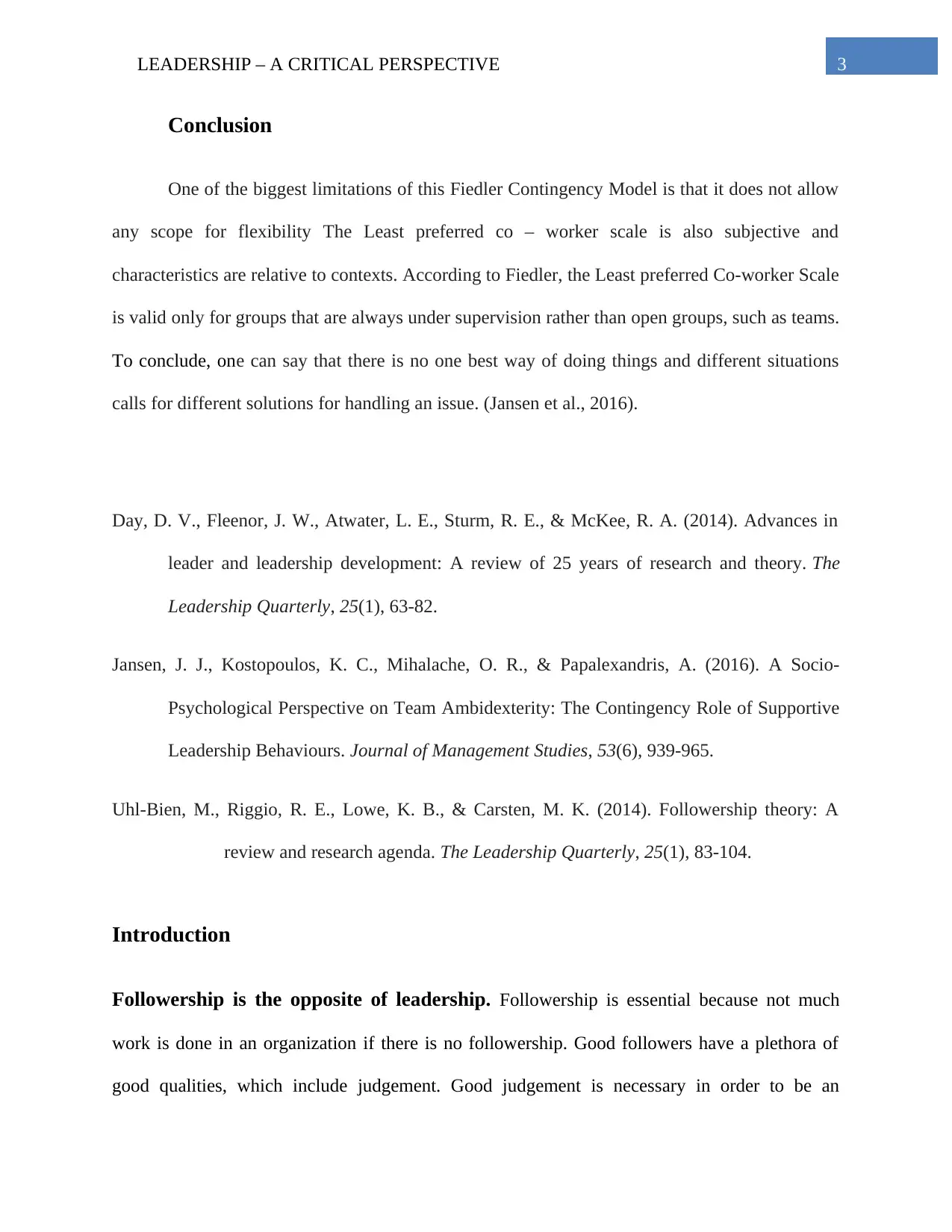
3LEADERSHIP – A CRITICAL PERSPECTIVE
Conclusion
One of the biggest limitations of this Fiedler Contingency Model is that it does not allow
any scope for flexibility The Least preferred co – worker scale is also subjective and
characteristics are relative to contexts. According to Fiedler, the Least preferred Co-worker Scale
is valid only for groups that are always under supervision rather than open groups, such as teams.
To conclude, one can say that there is no one best way of doing things and different situations
calls for different solutions for handling an issue. (Jansen et al., 2016).
Day, D. V., Fleenor, J. W., Atwater, L. E., Sturm, R. E., & McKee, R. A. (2014). Advances in
leader and leadership development: A review of 25 years of research and theory. The
Leadership Quarterly, 25(1), 63-82.
Jansen, J. J., Kostopoulos, K. C., Mihalache, O. R., & Papalexandris, A. (2016). A Socio‐
Psychological Perspective on Team Ambidexterity: The Contingency Role of Supportive
Leadership Behaviours. Journal of Management Studies, 53(6), 939-965.
Uhl-Bien, M., Riggio, R. E., Lowe, K. B., & Carsten, M. K. (2014). Followership theory: A
review and research agenda. The Leadership Quarterly, 25(1), 83-104.
Introduction
Followership is the opposite of leadership. Followership is essential because not much
work is done in an organization if there is no followership. Good followers have a plethora of
good qualities, which include judgement. Good judgement is necessary in order to be an
Conclusion
One of the biggest limitations of this Fiedler Contingency Model is that it does not allow
any scope for flexibility The Least preferred co – worker scale is also subjective and
characteristics are relative to contexts. According to Fiedler, the Least preferred Co-worker Scale
is valid only for groups that are always under supervision rather than open groups, such as teams.
To conclude, one can say that there is no one best way of doing things and different situations
calls for different solutions for handling an issue. (Jansen et al., 2016).
Day, D. V., Fleenor, J. W., Atwater, L. E., Sturm, R. E., & McKee, R. A. (2014). Advances in
leader and leadership development: A review of 25 years of research and theory. The
Leadership Quarterly, 25(1), 63-82.
Jansen, J. J., Kostopoulos, K. C., Mihalache, O. R., & Papalexandris, A. (2016). A Socio‐
Psychological Perspective on Team Ambidexterity: The Contingency Role of Supportive
Leadership Behaviours. Journal of Management Studies, 53(6), 939-965.
Uhl-Bien, M., Riggio, R. E., Lowe, K. B., & Carsten, M. K. (2014). Followership theory: A
review and research agenda. The Leadership Quarterly, 25(1), 83-104.
Introduction
Followership is the opposite of leadership. Followership is essential because not much
work is done in an organization if there is no followership. Good followers have a plethora of
good qualities, which include judgement. Good judgement is necessary in order to be an
Paraphrase This Document
Need a fresh take? Get an instant paraphrase of this document with our AI Paraphraser
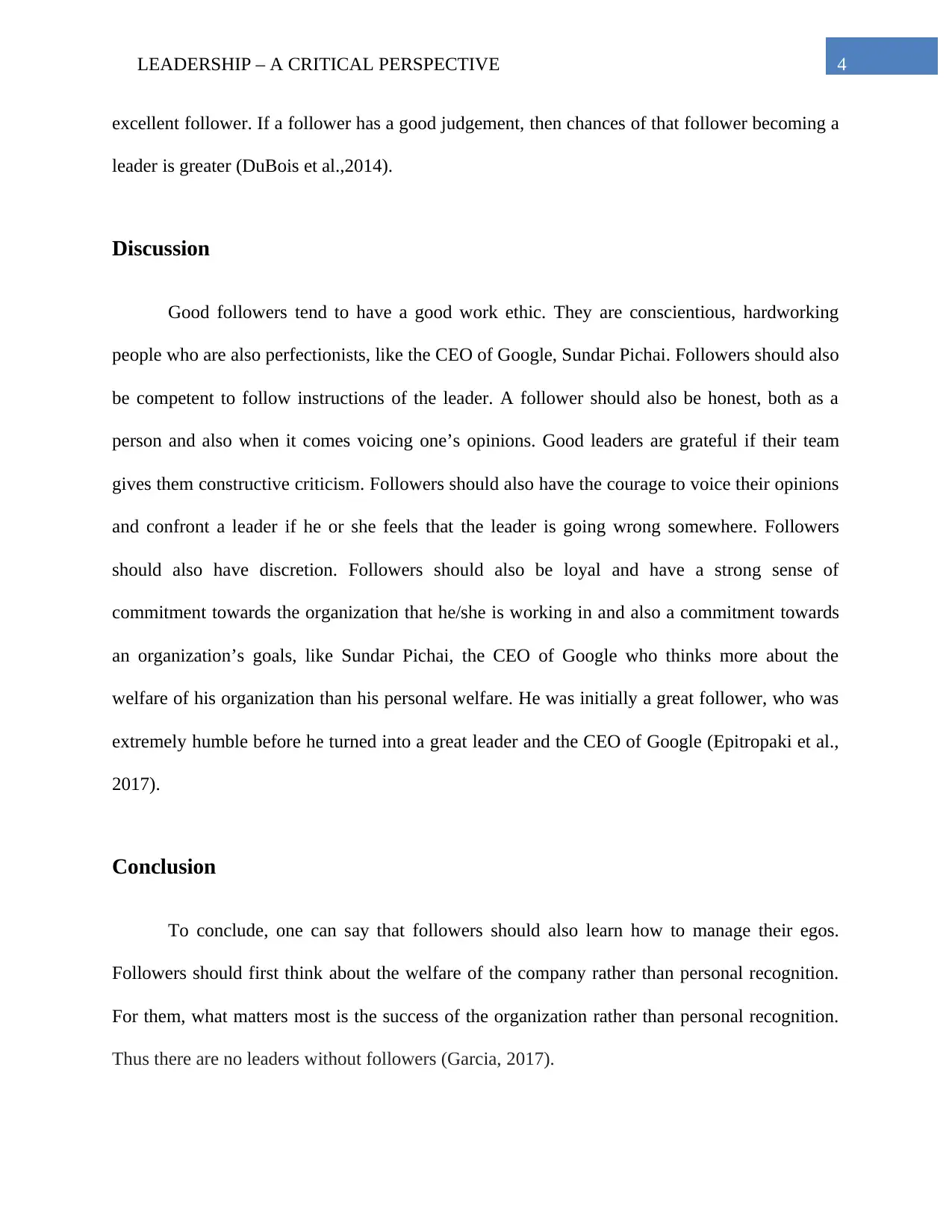
4LEADERSHIP – A CRITICAL PERSPECTIVE
excellent follower. If a follower has a good judgement, then chances of that follower becoming a
leader is greater (DuBois et al.,2014).
Discussion
Good followers tend to have a good work ethic. They are conscientious, hardworking
people who are also perfectionists, like the CEO of Google, Sundar Pichai. Followers should also
be competent to follow instructions of the leader. A follower should also be honest, both as a
person and also when it comes voicing one’s opinions. Good leaders are grateful if their team
gives them constructive criticism. Followers should also have the courage to voice their opinions
and confront a leader if he or she feels that the leader is going wrong somewhere. Followers
should also have discretion. Followers should also be loyal and have a strong sense of
commitment towards the organization that he/she is working in and also a commitment towards
an organization’s goals, like Sundar Pichai, the CEO of Google who thinks more about the
welfare of his organization than his personal welfare. He was initially a great follower, who was
extremely humble before he turned into a great leader and the CEO of Google (Epitropaki et al.,
2017).
Conclusion
To conclude, one can say that followers should also learn how to manage their egos.
Followers should first think about the welfare of the company rather than personal recognition.
For them, what matters most is the success of the organization rather than personal recognition.
Thus there are no leaders without followers (Garcia, 2017).
excellent follower. If a follower has a good judgement, then chances of that follower becoming a
leader is greater (DuBois et al.,2014).
Discussion
Good followers tend to have a good work ethic. They are conscientious, hardworking
people who are also perfectionists, like the CEO of Google, Sundar Pichai. Followers should also
be competent to follow instructions of the leader. A follower should also be honest, both as a
person and also when it comes voicing one’s opinions. Good leaders are grateful if their team
gives them constructive criticism. Followers should also have the courage to voice their opinions
and confront a leader if he or she feels that the leader is going wrong somewhere. Followers
should also have discretion. Followers should also be loyal and have a strong sense of
commitment towards the organization that he/she is working in and also a commitment towards
an organization’s goals, like Sundar Pichai, the CEO of Google who thinks more about the
welfare of his organization than his personal welfare. He was initially a great follower, who was
extremely humble before he turned into a great leader and the CEO of Google (Epitropaki et al.,
2017).
Conclusion
To conclude, one can say that followers should also learn how to manage their egos.
Followers should first think about the welfare of the company rather than personal recognition.
For them, what matters most is the success of the organization rather than personal recognition.
Thus there are no leaders without followers (Garcia, 2017).

5LEADERSHIP – A CRITICAL PERSPECTIVE
DuBois, M., Koch, J., Hanlon, J., Nyatuga, B., & Kerr, N. (2015). Leadership Styles of Effective
Project Managers: Techniques and Traits to Lead High Performance Teams. Journal of
Economic Development, Management, IT, Finance & Marketing, 7(1).
Epitropaki, O., Kark, R., Mainemelis, C., & Lord, R. G. (2017). Leadership and followership
identity processes: A multilevel review. The Leadership Quarterly, 28(1), 104-129.
Garcia, M. (2017). Followers’ Perspective Does Matter!(Follow up to You Have What?
Personality! Traits that Predict Leadership Styles for Elementary Principals). J Psychol
Psychother, 7(309), 2161-0487.
Introduction
Raymond Cattell, developed the Leadership Potential equation in 1954. This model
which was initially based on a study of military leaders, is now used to determine the traits of a
good leader. A good leader should have the following traits which include, honesty,
conscientiousness, emotional stability, enthusiasm, assertiveness, having a tough mind and being
self-assured (Leroy et al., 2015).
Discussion
Good leaders should be honest and also a good person from within, setting an example to
all those who look up to him. A good leader should also be emotionally stable and be able to
DuBois, M., Koch, J., Hanlon, J., Nyatuga, B., & Kerr, N. (2015). Leadership Styles of Effective
Project Managers: Techniques and Traits to Lead High Performance Teams. Journal of
Economic Development, Management, IT, Finance & Marketing, 7(1).
Epitropaki, O., Kark, R., Mainemelis, C., & Lord, R. G. (2017). Leadership and followership
identity processes: A multilevel review. The Leadership Quarterly, 28(1), 104-129.
Garcia, M. (2017). Followers’ Perspective Does Matter!(Follow up to You Have What?
Personality! Traits that Predict Leadership Styles for Elementary Principals). J Psychol
Psychother, 7(309), 2161-0487.
Introduction
Raymond Cattell, developed the Leadership Potential equation in 1954. This model
which was initially based on a study of military leaders, is now used to determine the traits of a
good leader. A good leader should have the following traits which include, honesty,
conscientiousness, emotional stability, enthusiasm, assertiveness, having a tough mind and being
self-assured (Leroy et al., 2015).
Discussion
Good leaders should be honest and also a good person from within, setting an example to
all those who look up to him. A good leader should also be emotionally stable and be able to
⊘ This is a preview!⊘
Do you want full access?
Subscribe today to unlock all pages.

Trusted by 1+ million students worldwide
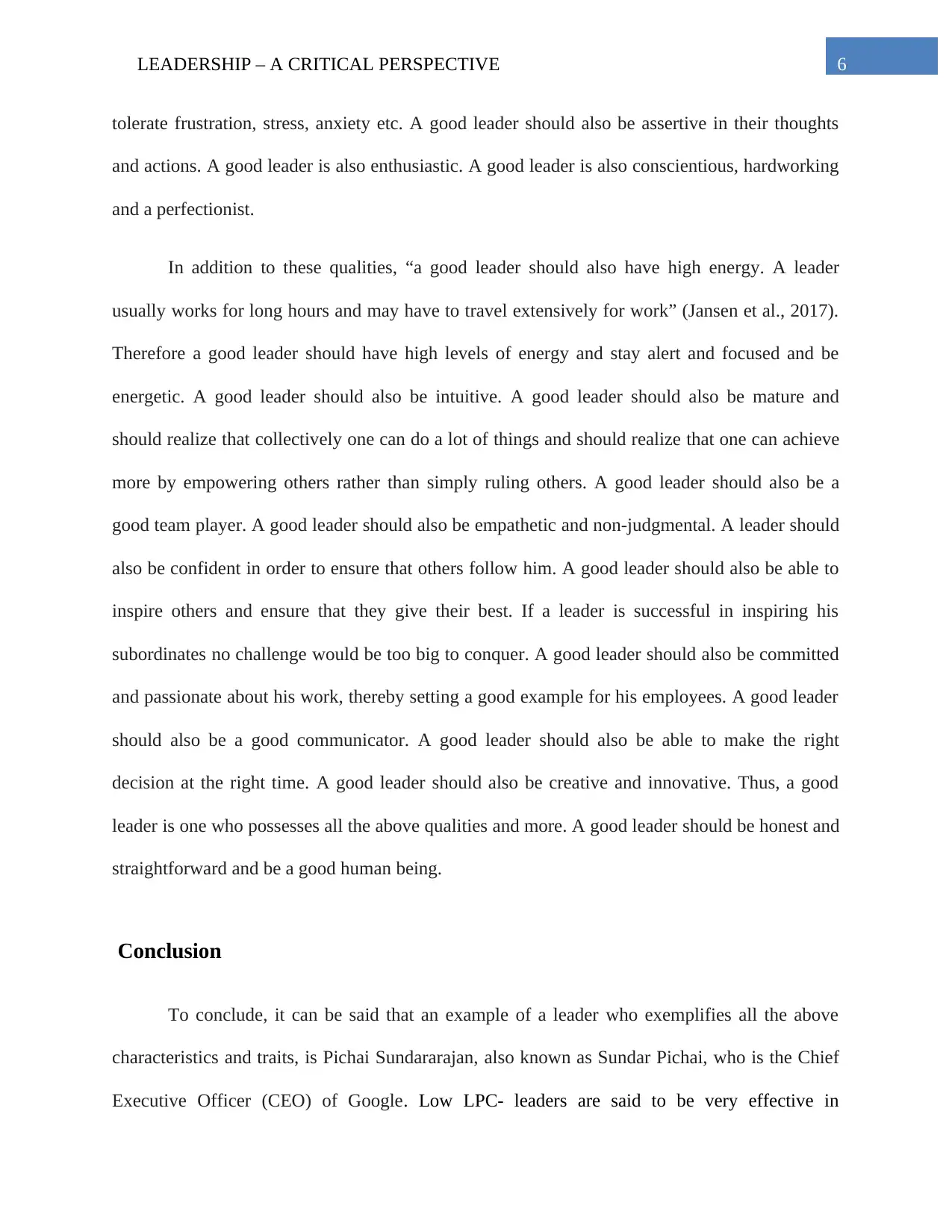
6LEADERSHIP – A CRITICAL PERSPECTIVE
tolerate frustration, stress, anxiety etc. A good leader should also be assertive in their thoughts
and actions. A good leader is also enthusiastic. A good leader is also conscientious, hardworking
and a perfectionist.
In addition to these qualities, “a good leader should also have high energy. A leader
usually works for long hours and may have to travel extensively for work” (Jansen et al., 2017).
Therefore a good leader should have high levels of energy and stay alert and focused and be
energetic. A good leader should also be intuitive. A good leader should also be mature and
should realize that collectively one can do a lot of things and should realize that one can achieve
more by empowering others rather than simply ruling others. A good leader should also be a
good team player. A good leader should also be empathetic and non-judgmental. A leader should
also be confident in order to ensure that others follow him. A good leader should also be able to
inspire others and ensure that they give their best. If a leader is successful in inspiring his
subordinates no challenge would be too big to conquer. A good leader should also be committed
and passionate about his work, thereby setting a good example for his employees. A good leader
should also be a good communicator. A good leader should also be able to make the right
decision at the right time. A good leader should also be creative and innovative. Thus, a good
leader is one who possesses all the above qualities and more. A good leader should be honest and
straightforward and be a good human being.
Conclusion
To conclude, it can be said that an example of a leader who exemplifies all the above
characteristics and traits, is Pichai Sundararajan, also known as Sundar Pichai, who is the Chief
Executive Officer (CEO) of Google. Low LPC- leaders are said to be very effective in
tolerate frustration, stress, anxiety etc. A good leader should also be assertive in their thoughts
and actions. A good leader is also enthusiastic. A good leader is also conscientious, hardworking
and a perfectionist.
In addition to these qualities, “a good leader should also have high energy. A leader
usually works for long hours and may have to travel extensively for work” (Jansen et al., 2017).
Therefore a good leader should have high levels of energy and stay alert and focused and be
energetic. A good leader should also be intuitive. A good leader should also be mature and
should realize that collectively one can do a lot of things and should realize that one can achieve
more by empowering others rather than simply ruling others. A good leader should also be a
good team player. A good leader should also be empathetic and non-judgmental. A leader should
also be confident in order to ensure that others follow him. A good leader should also be able to
inspire others and ensure that they give their best. If a leader is successful in inspiring his
subordinates no challenge would be too big to conquer. A good leader should also be committed
and passionate about his work, thereby setting a good example for his employees. A good leader
should also be a good communicator. A good leader should also be able to make the right
decision at the right time. A good leader should also be creative and innovative. Thus, a good
leader is one who possesses all the above qualities and more. A good leader should be honest and
straightforward and be a good human being.
Conclusion
To conclude, it can be said that an example of a leader who exemplifies all the above
characteristics and traits, is Pichai Sundararajan, also known as Sundar Pichai, who is the Chief
Executive Officer (CEO) of Google. Low LPC- leaders are said to be very effective in
Paraphrase This Document
Need a fresh take? Get an instant paraphrase of this document with our AI Paraphraser
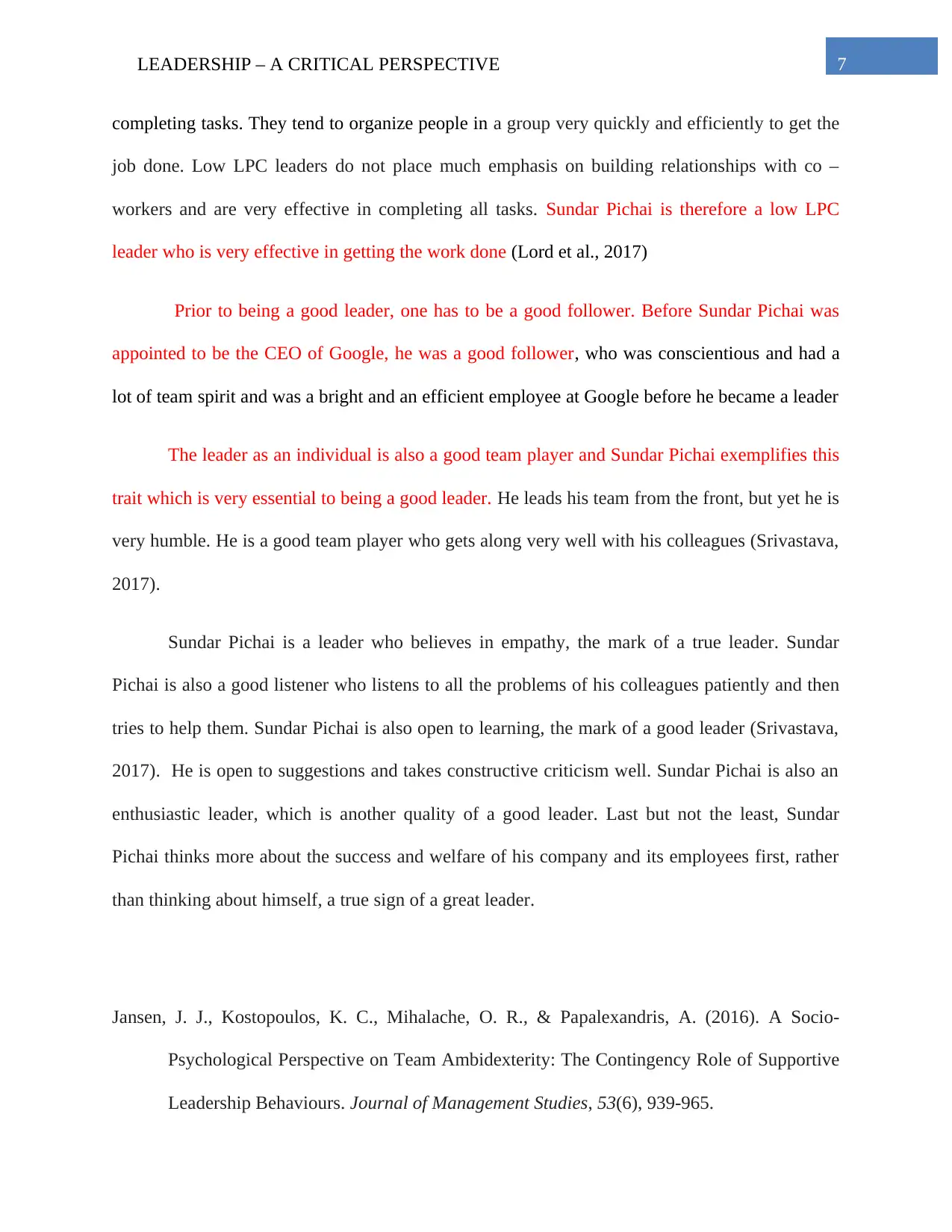
7LEADERSHIP – A CRITICAL PERSPECTIVE
completing tasks. They tend to organize people in a group very quickly and efficiently to get the
job done. Low LPC leaders do not place much emphasis on building relationships with co –
workers and are very effective in completing all tasks. Sundar Pichai is therefore a low LPC
leader who is very effective in getting the work done (Lord et al., 2017)
Prior to being a good leader, one has to be a good follower. Before Sundar Pichai was
appointed to be the CEO of Google, he was a good follower, who was conscientious and had a
lot of team spirit and was a bright and an efficient employee at Google before he became a leader
The leader as an individual is also a good team player and Sundar Pichai exemplifies this
trait which is very essential to being a good leader. He leads his team from the front, but yet he is
very humble. He is a good team player who gets along very well with his colleagues (Srivastava,
2017).
Sundar Pichai is a leader who believes in empathy, the mark of a true leader. Sundar
Pichai is also a good listener who listens to all the problems of his colleagues patiently and then
tries to help them. Sundar Pichai is also open to learning, the mark of a good leader (Srivastava,
2017). He is open to suggestions and takes constructive criticism well. Sundar Pichai is also an
enthusiastic leader, which is another quality of a good leader. Last but not the least, Sundar
Pichai thinks more about the success and welfare of his company and its employees first, rather
than thinking about himself, a true sign of a great leader.
Jansen, J. J., Kostopoulos, K. C., Mihalache, O. R., & Papalexandris, A. (2016). A Socio‐
Psychological Perspective on Team Ambidexterity: The Contingency Role of Supportive
Leadership Behaviours. Journal of Management Studies, 53(6), 939-965.
completing tasks. They tend to organize people in a group very quickly and efficiently to get the
job done. Low LPC leaders do not place much emphasis on building relationships with co –
workers and are very effective in completing all tasks. Sundar Pichai is therefore a low LPC
leader who is very effective in getting the work done (Lord et al., 2017)
Prior to being a good leader, one has to be a good follower. Before Sundar Pichai was
appointed to be the CEO of Google, he was a good follower, who was conscientious and had a
lot of team spirit and was a bright and an efficient employee at Google before he became a leader
The leader as an individual is also a good team player and Sundar Pichai exemplifies this
trait which is very essential to being a good leader. He leads his team from the front, but yet he is
very humble. He is a good team player who gets along very well with his colleagues (Srivastava,
2017).
Sundar Pichai is a leader who believes in empathy, the mark of a true leader. Sundar
Pichai is also a good listener who listens to all the problems of his colleagues patiently and then
tries to help them. Sundar Pichai is also open to learning, the mark of a good leader (Srivastava,
2017). He is open to suggestions and takes constructive criticism well. Sundar Pichai is also an
enthusiastic leader, which is another quality of a good leader. Last but not the least, Sundar
Pichai thinks more about the success and welfare of his company and its employees first, rather
than thinking about himself, a true sign of a great leader.
Jansen, J. J., Kostopoulos, K. C., Mihalache, O. R., & Papalexandris, A. (2016). A Socio‐
Psychological Perspective on Team Ambidexterity: The Contingency Role of Supportive
Leadership Behaviours. Journal of Management Studies, 53(6), 939-965.
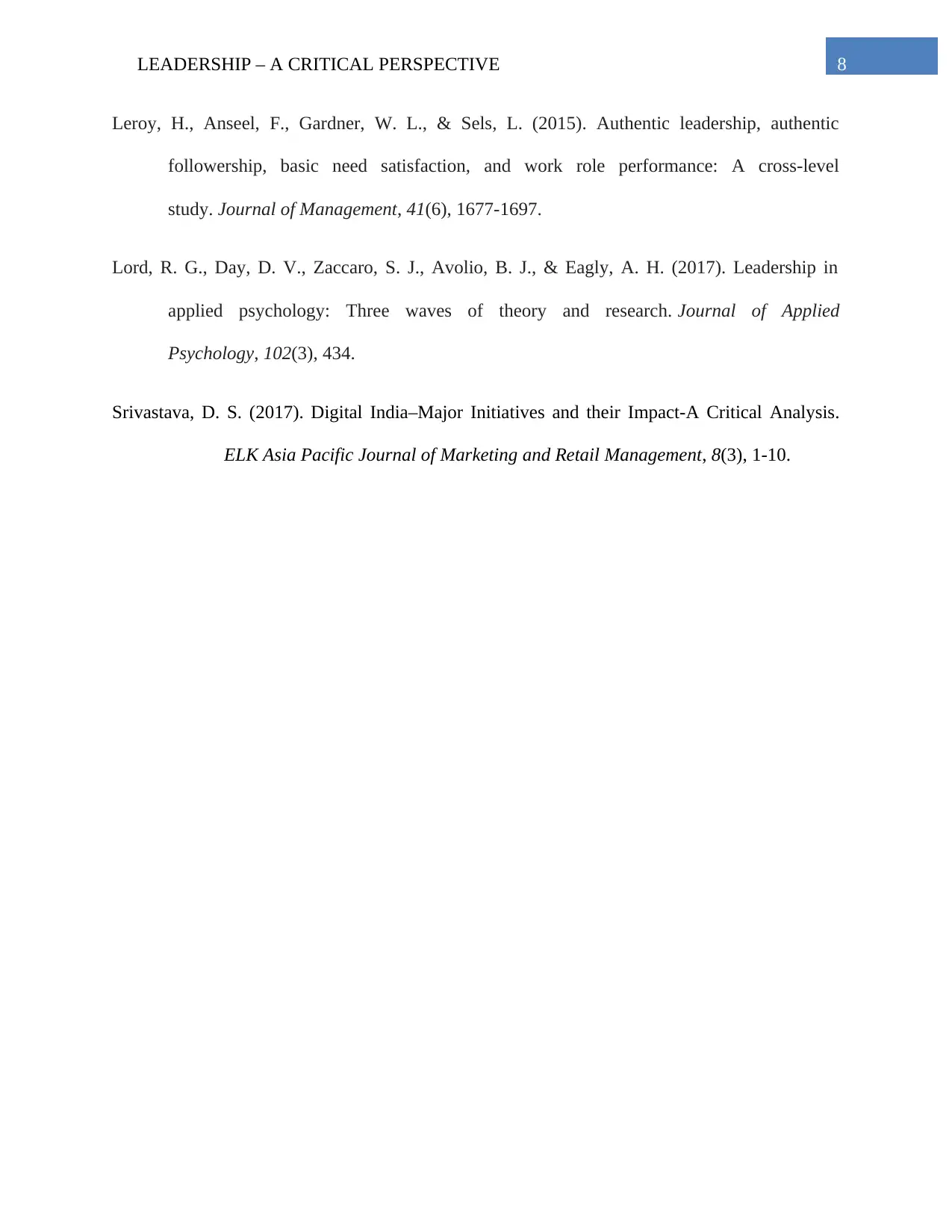
8LEADERSHIP – A CRITICAL PERSPECTIVE
Leroy, H., Anseel, F., Gardner, W. L., & Sels, L. (2015). Authentic leadership, authentic
followership, basic need satisfaction, and work role performance: A cross-level
study. Journal of Management, 41(6), 1677-1697.
Lord, R. G., Day, D. V., Zaccaro, S. J., Avolio, B. J., & Eagly, A. H. (2017). Leadership in
applied psychology: Three waves of theory and research. Journal of Applied
Psychology, 102(3), 434.
Srivastava, D. S. (2017). Digital India–Major Initiatives and their Impact-A Critical Analysis.
ELK Asia Pacific Journal of Marketing and Retail Management, 8(3), 1-10.
Leroy, H., Anseel, F., Gardner, W. L., & Sels, L. (2015). Authentic leadership, authentic
followership, basic need satisfaction, and work role performance: A cross-level
study. Journal of Management, 41(6), 1677-1697.
Lord, R. G., Day, D. V., Zaccaro, S. J., Avolio, B. J., & Eagly, A. H. (2017). Leadership in
applied psychology: Three waves of theory and research. Journal of Applied
Psychology, 102(3), 434.
Srivastava, D. S. (2017). Digital India–Major Initiatives and their Impact-A Critical Analysis.
ELK Asia Pacific Journal of Marketing and Retail Management, 8(3), 1-10.
⊘ This is a preview!⊘
Do you want full access?
Subscribe today to unlock all pages.

Trusted by 1+ million students worldwide

9LEADERSHIP – A CRITICAL PERSPECTIVE
Paraphrase This Document
Need a fresh take? Get an instant paraphrase of this document with our AI Paraphraser
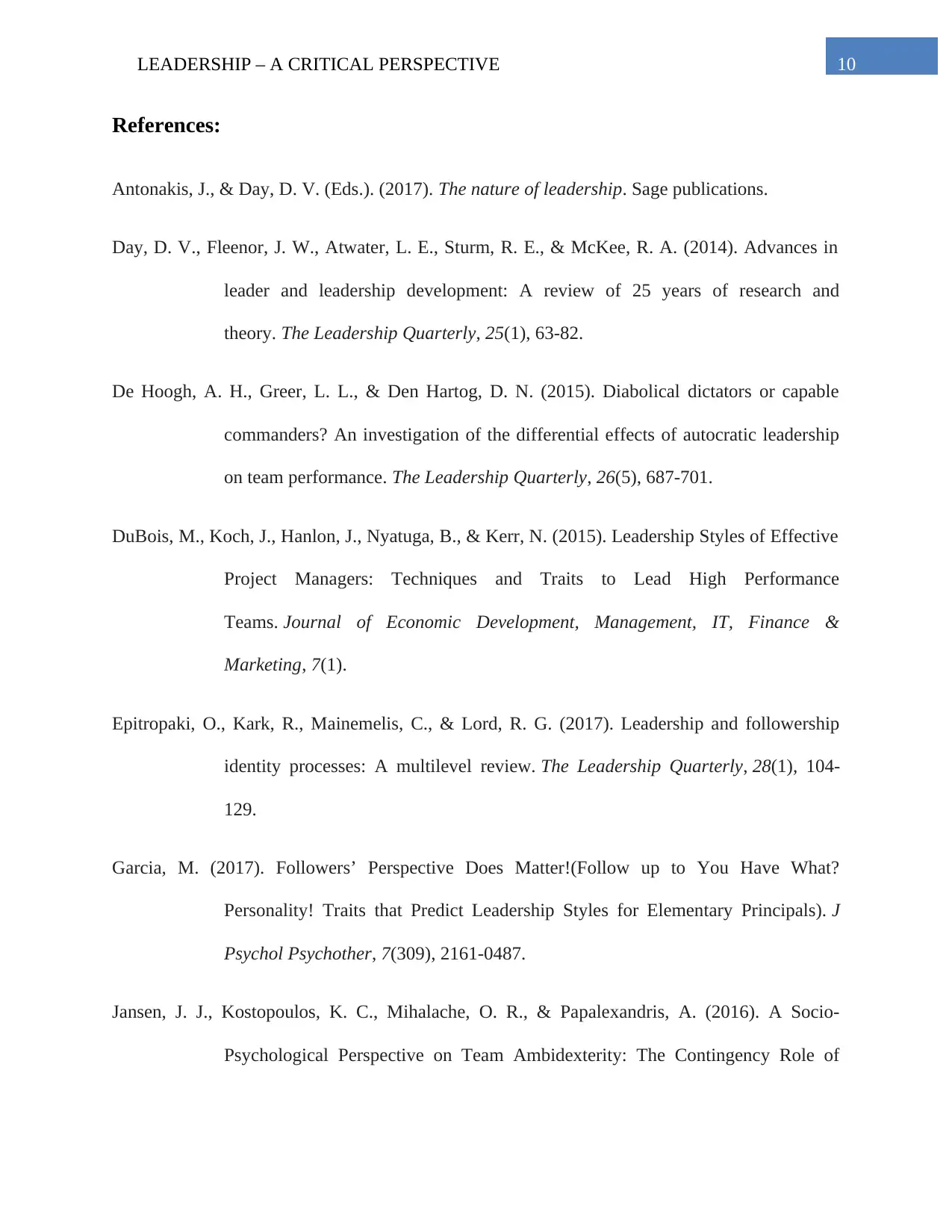
10LEADERSHIP – A CRITICAL PERSPECTIVE
References:
Antonakis, J., & Day, D. V. (Eds.). (2017). The nature of leadership. Sage publications.
Day, D. V., Fleenor, J. W., Atwater, L. E., Sturm, R. E., & McKee, R. A. (2014). Advances in
leader and leadership development: A review of 25 years of research and
theory. The Leadership Quarterly, 25(1), 63-82.
De Hoogh, A. H., Greer, L. L., & Den Hartog, D. N. (2015). Diabolical dictators or capable
commanders? An investigation of the differential effects of autocratic leadership
on team performance. The Leadership Quarterly, 26(5), 687-701.
DuBois, M., Koch, J., Hanlon, J., Nyatuga, B., & Kerr, N. (2015). Leadership Styles of Effective
Project Managers: Techniques and Traits to Lead High Performance
Teams. Journal of Economic Development, Management, IT, Finance &
Marketing, 7(1).
Epitropaki, O., Kark, R., Mainemelis, C., & Lord, R. G. (2017). Leadership and followership
identity processes: A multilevel review. The Leadership Quarterly, 28(1), 104-
129.
Garcia, M. (2017). Followers’ Perspective Does Matter!(Follow up to You Have What?
Personality! Traits that Predict Leadership Styles for Elementary Principals). J
Psychol Psychother, 7(309), 2161-0487.
Jansen, J. J., Kostopoulos, K. C., Mihalache, O. R., & Papalexandris, A. (2016). A Socio‐
Psychological Perspective on Team Ambidexterity: The Contingency Role of
References:
Antonakis, J., & Day, D. V. (Eds.). (2017). The nature of leadership. Sage publications.
Day, D. V., Fleenor, J. W., Atwater, L. E., Sturm, R. E., & McKee, R. A. (2014). Advances in
leader and leadership development: A review of 25 years of research and
theory. The Leadership Quarterly, 25(1), 63-82.
De Hoogh, A. H., Greer, L. L., & Den Hartog, D. N. (2015). Diabolical dictators or capable
commanders? An investigation of the differential effects of autocratic leadership
on team performance. The Leadership Quarterly, 26(5), 687-701.
DuBois, M., Koch, J., Hanlon, J., Nyatuga, B., & Kerr, N. (2015). Leadership Styles of Effective
Project Managers: Techniques and Traits to Lead High Performance
Teams. Journal of Economic Development, Management, IT, Finance &
Marketing, 7(1).
Epitropaki, O., Kark, R., Mainemelis, C., & Lord, R. G. (2017). Leadership and followership
identity processes: A multilevel review. The Leadership Quarterly, 28(1), 104-
129.
Garcia, M. (2017). Followers’ Perspective Does Matter!(Follow up to You Have What?
Personality! Traits that Predict Leadership Styles for Elementary Principals). J
Psychol Psychother, 7(309), 2161-0487.
Jansen, J. J., Kostopoulos, K. C., Mihalache, O. R., & Papalexandris, A. (2016). A Socio‐
Psychological Perspective on Team Ambidexterity: The Contingency Role of
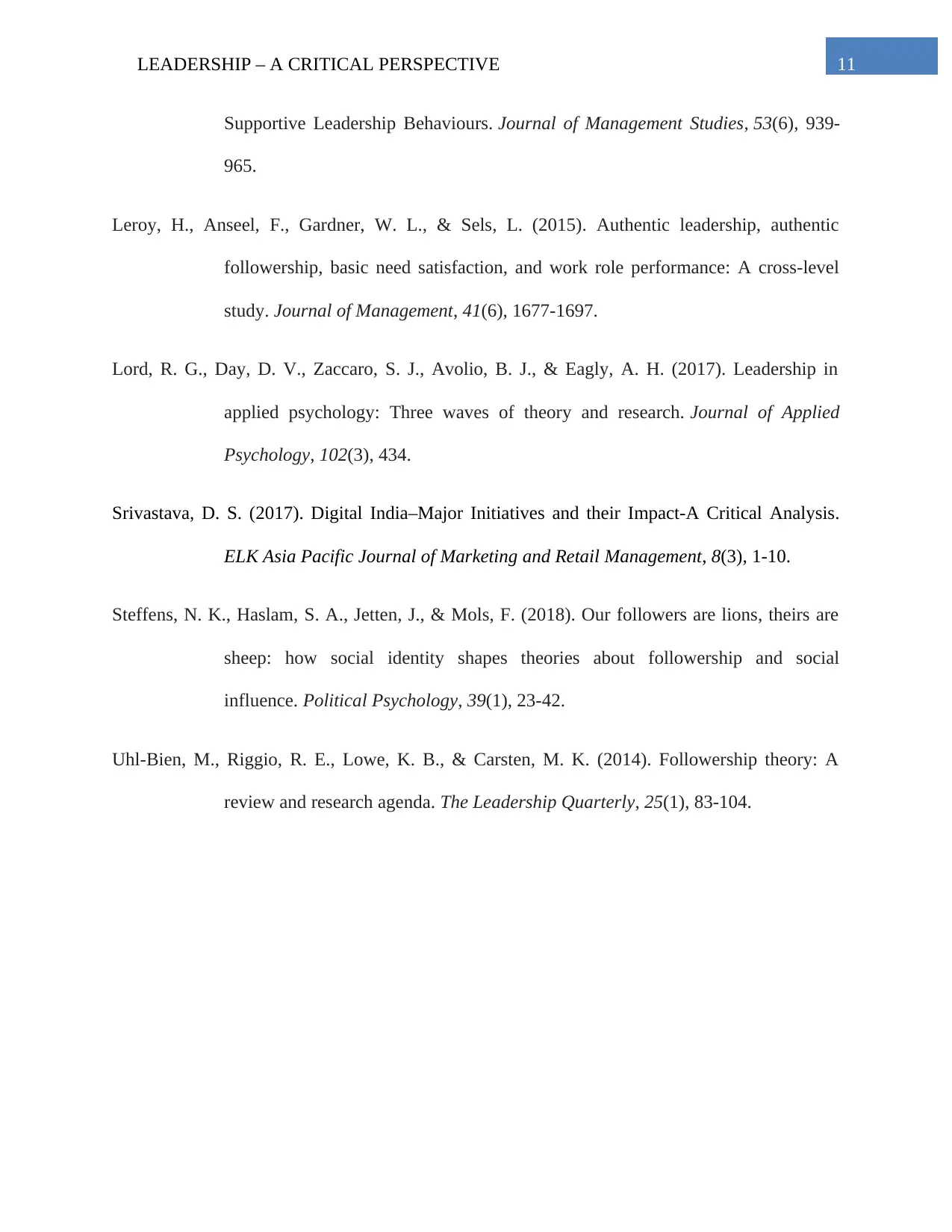
11LEADERSHIP – A CRITICAL PERSPECTIVE
Supportive Leadership Behaviours. Journal of Management Studies, 53(6), 939-
965.
Leroy, H., Anseel, F., Gardner, W. L., & Sels, L. (2015). Authentic leadership, authentic
followership, basic need satisfaction, and work role performance: A cross-level
study. Journal of Management, 41(6), 1677-1697.
Lord, R. G., Day, D. V., Zaccaro, S. J., Avolio, B. J., & Eagly, A. H. (2017). Leadership in
applied psychology: Three waves of theory and research. Journal of Applied
Psychology, 102(3), 434.
Srivastava, D. S. (2017). Digital India–Major Initiatives and their Impact-A Critical Analysis.
ELK Asia Pacific Journal of Marketing and Retail Management, 8(3), 1-10.
Steffens, N. K., Haslam, S. A., Jetten, J., & Mols, F. (2018). Our followers are lions, theirs are
sheep: how social identity shapes theories about followership and social
influence. Political Psychology, 39(1), 23-42.
Uhl-Bien, M., Riggio, R. E., Lowe, K. B., & Carsten, M. K. (2014). Followership theory: A
review and research agenda. The Leadership Quarterly, 25(1), 83-104.
Supportive Leadership Behaviours. Journal of Management Studies, 53(6), 939-
965.
Leroy, H., Anseel, F., Gardner, W. L., & Sels, L. (2015). Authentic leadership, authentic
followership, basic need satisfaction, and work role performance: A cross-level
study. Journal of Management, 41(6), 1677-1697.
Lord, R. G., Day, D. V., Zaccaro, S. J., Avolio, B. J., & Eagly, A. H. (2017). Leadership in
applied psychology: Three waves of theory and research. Journal of Applied
Psychology, 102(3), 434.
Srivastava, D. S. (2017). Digital India–Major Initiatives and their Impact-A Critical Analysis.
ELK Asia Pacific Journal of Marketing and Retail Management, 8(3), 1-10.
Steffens, N. K., Haslam, S. A., Jetten, J., & Mols, F. (2018). Our followers are lions, theirs are
sheep: how social identity shapes theories about followership and social
influence. Political Psychology, 39(1), 23-42.
Uhl-Bien, M., Riggio, R. E., Lowe, K. B., & Carsten, M. K. (2014). Followership theory: A
review and research agenda. The Leadership Quarterly, 25(1), 83-104.
⊘ This is a preview!⊘
Do you want full access?
Subscribe today to unlock all pages.

Trusted by 1+ million students worldwide
1 out of 12
Related Documents
Your All-in-One AI-Powered Toolkit for Academic Success.
+13062052269
info@desklib.com
Available 24*7 on WhatsApp / Email
![[object Object]](/_next/static/media/star-bottom.7253800d.svg)
Unlock your academic potential
Copyright © 2020–2025 A2Z Services. All Rights Reserved. Developed and managed by ZUCOL.



